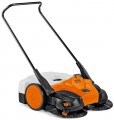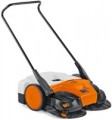Performance
The performance of a cleaning machine is the area that the unit can process in an hour.
Usually, the specs indicate the maximum performance achieved under perfect conditions. It may turn out to be somewhat lower due to the specs of the room, the presence of old dirt and other factors. However, the theoretical difference is usually quite consistent with the actual one. For example, models for 1000 m2/h and 2000 m2/h will differ in performance approximately by two times. So, according to this parameter, it is quite possible to evaluate different models and compare them with each other.
Note that high performance requires a powerful motor and capacious tanks, which affects the dimensions, weight and cost of the unit. Therefore, excessive performance is just as undesirable as insufficient. In addition, more powerful machines usually have a larger working width and are not well suited for rooms with an abundance of narrow passages and nooks and crannies.
As for the actual values, models
less than 1000 m2/h belong to the entry-level. It is the specs that most household machines have (see "Type"). A value
from 1000 to 2000 m2/h is relatively low for professional sweepers and the average for scrubber dryers.
2000 – 3000 m2/h is considered a fairly solid performance, and models of
more than 3000 m2/h is extremely ra
...re. These are mostly high-end sweepers (it is extremely difficult to achieve such characteristics in scrubbers).Battery type
The type of battery used in the machine with the appropriate power supply (see above). The type is indicated by the technology by which the battery is made.
— Ni-Cd. One of the oldest modern technologies. Such elements are capable of operating at high discharge currents, which is especially important for heavy and powerful equipment with high power consumption. In addition, they charge quickly enough, endure work in the cold and temperature fluctuations without any problems, and are relatively inexpensive. One of the main disadvantages of nickel-cadmium batteries is the so-called memory effect — a decrease in capacity if charging was carried out until it was completely discharged. However, this disadvantage can be compensated by the use of high-quality chargers and compliance with the operating rules. But the unequivocal disadvantage of this variety is the environmental insecurity in production and disposal; it limits the use of Ni-Cd batteries in modern technology.
— Ni-Mh. A technology created in an attempt to improve the performance of the nickel-cadmium batteries described above. The attempt turned out to be quite successful: while retaining the main advantages of their predecessors, nickel-metal-hydride cells are at the same time less susceptible to the memory effect and more environmentally friendly. Their disadvantages include a slightly increased cost and specific rules for long-term storage.
— Li-Ion. Lithium-ion batteries are rema...rkable primarily for their high charge density — in other words, they have a high capacity with small dimensions and weight. It is especially important for compact devices such as robots or handheld window cleaners (see "Type"). In addition, such batteries are practically not subject to the memory effect. Among the disadvantages of this technology, in addition to the cost, it is worth mentioning the sensitivity to high and low temperatures, as well as the likelihood of “accidents” during abnormal modes: failure of the built-in controller with overcharging or overdischarging, overheating or short circuit can lead to swelling, electrolyte leakage and even fire.
— Li-Po. A type of lithium-ion battery (see above), in which a polymer (gel) electrolyte is used instead of a liquid electrolyte. This design provides additional advantages over the original Li-Ion technology: lithium-polymer batteries have an even higher charge density, and the likelihood of "accidents" with explosions and fires in them is noticeably reduced. The main disadvantages of such power supplies are the rather high cost and the exactingness of maintaining the optimal temperature regime.
— Gel. In this case, we are usually talking about gel lead-acid batteries, similar to those used in cars. Such batteries are distinguished by their considerable weight. Therefore they are used exclusively in heavy cleaning equipment, where several kilograms of the battery weight is invisible against the weight of the machine itself. Of the practical advantages of such batteries, it is worth noting good capacity, durability, the ability to tolerate deep discharge without problems, as well as resistance to low temperatures and temperature extremes.
Noise level
The noise level created by the harvesting machine during operation.
Low noise levels are important for the comfort of both the operator and others; the latter is especially true in some specific places such as hospitals or kindergartens. On the other hand, the higher the power, the louder, as a rule, the unit operates and the more difficult it is to reduce this noise to a certain level; despite the fact that in many cases high volume operation is not a particular problem. So you should specifically look for a “quiet” cleaning machine only if a low noise level is more critical for you than high cost and/or reduced power.
When assessing specific loudness values, it is worth considering that the decibel used to indicate the noise level is a non-linear quantity. Therefore, the easiest way is to evaluate specific values using comparative tables. Here's a simplified table for the range that most modern harvesting machines fit into:
55 dB - background noise in an office without special noise sources;
60 dB - loud conversation;
65 dB - city street with average traffic intensity;
70 dB - a conversation between several people in a raised voice.
75 dB – high power vacuum cleaner.
80 dB - traffic noise on a busy street.
Weight
The total weight of the cleaning machine. Usually, weight is indicated with empty tanks for detergent, waste, fuel, etc. At the same time, additional equipment, such as side brushes, may or may not be taken into account. Such equipment has a very small weight compared to the machines themselves. And, when installed/removed, does not seriously affect the mass of the entire machine.

